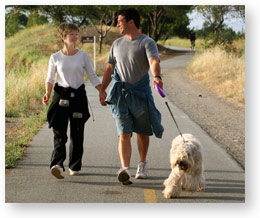The American College of Sports Medicine (ACSM) defines aerobic exercise as “any activity that uses large muscle groups, can be maintained continuously, and is rhythmic in nature.”
There are several things to consider with your cardiovascular (aerobic) activities:
- Frequency – How many days a week should I exercise?
- Duration – How Long Should My Workouts Be?
- Intensity – How Hard Should My Workouts Be?
Most experts recommend for general fitness that the frequency of aerobic training sessions be three to five times per week, with a duration of between 20-60 minutes, and an elevated heart rate in the appropriate zone based on your age and current fitness level.
(See the chart below for calculating your intensity.)
The American Heart Association recommends measuring your pulse rate periodically during exercise to be sure you are working at an appropriate pace. Guidelines are to stay within 50-85% of your maximum heart rate. Use the table below to determine your Target Heart Rate Zone.
| Age | Target HR Zone: 50-85% | Average Maximum Heart Rate: 100% |
|---|---|---|
| 20 years | 100 – 170 beats per minute | 200 beats per minute |
| 25 years | 98 – 166 beats per minute | 195 beats per minute |
| 30 years | 95 – 162 beats per minute | 190 beats per minute |
| 35 years | 93 – 157 beats per minute | 185 beats per minute |
| 40 years | 90 – 153 beats per minute | 180 beats per minute |
| 45 years | 88 – 149 beats per minute | 175 beats per minute |
| 50 years | 85 – 145 beats per minute | 170 beats per minute |
| 55 years | 83 – 140 beats per minute | 165 beats per minute |
| 60 years | 80 – 136 beats per minute | 160 beats per minute |
| 65 years | 78 – 132 beats per minute | 155 beats per minute |
| 70 years | 75 – 128 beats per minute | 150 beats per minute |
To calculate your maximum heart rate, figure 220 minus your age. The numbers in the chart above are averages, so use them as general guidelines.
Note: A few high blood pressure medications lower the maximum heart rate and thus the target zone rate. If you’re taking such medicine, call your physician to find out if you need to use a lower target heart rate, or how to safely monitor your heart rate during exercise.
 How Do I Determine An Appropriate Pace?
How Do I Determine An Appropriate Pace?
When starting an exercise program, begin exercising at the lowest part of your target zone (50 percent) during the first few weeks. Gradually build up to the higher part of your target zone range (75 percent).
After six months or more of regular exercise, you may be able to exercise comfortably at up to 85 percent of your maximum heart rate. However, keep in mind that you don’t have to exercise that hard to stay in shape.
 How Do I Check My Heart Rate?
How Do I Check My Heart Rate?
There are two pulse points that you can use to check your heart rate:
- Radial Pulse Point – Place your index and middle finger gently across the inside of your wrist. (On the thumb side of your wrist).
- Carotid Pulse Point – Place your index and middle fingers gently along the side of your neck, about 1-2 inches to the side and up from the center of your throat.
* Be sure you don’t use your thumb to check your pulse points.It has a pulse too and will make it difficult to get an accurate reading!
What is an alternative method to checking my target heart rate?
Some people have difficulty measuring, or don’t want to take their pulse when exercising. If this is true for you, try using “perceived exertion” to monitor your efforts during your aerobic activities. If you can talk and move at the same time, you are working at an appropriate pace. If you can sing and maintain your level of effort, you’re probably not working hard enough. If you get out of breath quickly, you’re probably working too hard – especially if you have to stop and catch your breath.
If you like gadgets…There are lots of electronic monitors you can purchase to help you keep track of your heart rate, pace, and distance during your workouts.
WHAT’S MOST IMPORTANT IS THAT YOU FIND AEROBIC ACTIVITIES THAT YOU ENJOY.

Get up and get moving with these great aerobic conditioning options!
- Walk
- Jog, Run
- Bicycle
- Swim
- Jump Rope
- Dance
- Climb Stairs
- Aerobic Class
- Water Aerobics
- Hike
- Basketball
- Inline Skating
- Cross-Country Ski
- You might have other fun activities you enjoy, too!
[brclear]
Health and Fitness Activities You May Enjoy
[brclear]


0 Comments